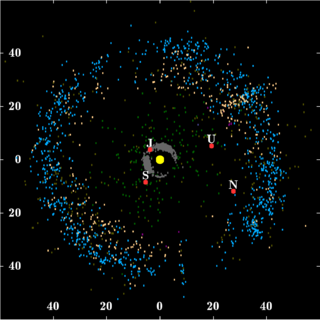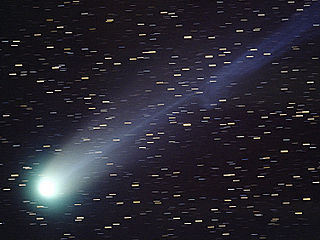
A comet is an icy, small Solar System body that, when passing close to the Sun, warms and begins to release gases, a process that is called outgassing. This produces a visible atmosphere or coma, and sometimes also a tail. These phenomena are due to the effects of solar radiation and the solar wind acting upon the nucleus of the comet. Comet nuclei range from a few hundred meters to tens of kilometers across and are composed of loose collections of ice, dust, and small rocky particles. The coma may be up to 15 times Earth's diameter, while the tail may stretch beyond one astronomical unit. If sufficiently bright, a comet may be seen from Earth without the aid of a telescope and may subtend an arc of 30° across the sky. Comets have been observed and recorded since ancient times by many cultures and religions.
Comet Shoemaker–Levy 9 was a comet that broke apart in July 1992 and collided with Jupiter in July 1994, providing the first direct observation of an extraterrestrial collision of Solar System objects. This generated a large amount of coverage in the popular media, and the comet was closely observed by astronomers worldwide. The collision provided new information about Jupiter and highlighted its possible role in reducing space debris in the inner Solar System.

Comet Hale–Bopp is a comet that was perhaps the most widely observed of the 20th century and one of the brightest seen for many decades.

A planet is an astronomical body orbiting a star or stellar remnant that is massive enough to be rounded by its own gravity, is not massive enough to cause thermonuclear fusion, and – according to the International Astronomical Union but not all planetary scientists – has cleared its neighbouring region of planetesimals.

The asteroid belt is a torus-shaped region in the Solar System, located roughly between the orbits of the planets Jupiter and Mars. It contains a great many solid, irregularly shaped bodies, of many sizes but much smaller than planets, called asteroids or minor planets. This asteroid belt is also called the main asteroid belt or main belt to distinguish it from other asteroid populations in the Solar System such as near-Earth asteroids and trojan asteroids.

A centaur, in planetary astronomy, is a small Solar System body with either a perihelion or a semi-major axis between those of the outer planets. Centaurs generally have unstable orbits because they cross or have crossed the orbits of one or more of the giant planets; almost all their orbits have dynamic lifetimes of only a few million years, but there is one known centaur, 514107 Kaʻepaokaʻawela, which may be in a stable orbit. Centaurs typically exhibit the characteristics of both asteroids and comets. They are named after the mythological centaurs that were a mixture of horse and human. Observational bias toward large objects makes determination of the total centaur population difficult. Estimates for the number of centaurs in the Solar System more than 1 km in diameter range from as low as 44,000 to more than 10,000,000.

1566 Icarus is a large near-Earth object of the Apollo group and the lowest numbered potentially hazardous asteroid. It has is an extremely eccentric orbit (0.83) and measures approximately 1.4 km (0.87 mi) in diameter. In 1968, it became the first asteroid ever observed by radar. Its orbit brings it closer to the Sun than Mercury and further out than the orbit of Mars, which also makes it a Mercury-, Venus-, and Mars-crossing asteroid. This stony asteroid and relatively fast rotator with a period of 2.27 hours was discovered on 27 June 1949, by German astronomer Walter Baade at the Palomar Observatory in California. It was named after the mythological Icarus.

Ausonia is a stony Vestian asteroid from the inner region of the asteroid belt, approximately 100 kilometers in diameter. It was discovered by Italian astronomer Annibale de Gasparis on 10 February 1861, from the Astronomical Observatory of Capodimonte, in Naples, Italy. The initial choice of name for the asteroid was "Italia", after Italy, but this was modified to Ausonia, an ancient classical name for the Italian region.
Xanthippe is a dark background asteroid from the central regions of the asteroid belt, approximately 120 kilometers in diameter. It was discovered on 22 November 1875, by Austrian astronomer Johann Palisa at the Austrian Naval Observatory, in what is now Croatia. It is named after Xanthippe, the wife of the Greek philosopher Socrates.

391 Ingeborg is an asteroid and second-largest Mars-crosser on an eccentric orbit from the asteroid belt. It was discovered by German astronomer Max Wolf on 1 November 1894, at the Heidelberg Observatory in southwest Germany. When discovered, it was observed for a couple of weeks, and follow-up observations were made in 1901 and 1904. The stony S-type asteroid has a rotation period of 26.4 hours and measures approximately 17 kilometers in diameter. Any reference of the asteroid's name to a person is unknown.

In astrophysics, accretion is the accumulation of particles into a massive object by gravitationally attracting more matter, typically gaseous matter, in an accretion disk. Most astronomical objects, such as galaxies, stars, and planets, are formed by accretion processes.

1023 Thomana, provisional designation 1924 RU, is a rare-type carbonaceous background asteroid from the outer regions of the asteroid belt, approximately 58 kilometers in diameter. It was discovered on 25 June 1924, by German astronomer Karl Reinmuth at Heidelberg Observatory in southwest Germany. The asteroid was named after the St. Thomas Choir of Leipzig.

2708 Burns is a carbonaceous Themistian asteroid from the outer regions of the asteroid belt, approximately 19 kilometers in diameter. It was discovered on 24 November 1981, by American astronomer Edward Bowell at the Anderson Mesa Station near Flagstaff, Arizona, in the United States. It was named after American planetary scientist Joseph A. Burns. The likely elongated B-type asteroid has a rotation period of 5.3 hours.

The Nicemodel is a scenario for the dynamical evolution of the Solar System. It is named for the location of the Observatoire de la Côte d'Azur — where it was initially developed in 2005 — in Nice, France. It proposes the migration of the giant planets from an initial compact configuration into their present positions, long after the dissipation of the initial protoplanetary disk. In this way, it differs from earlier models of the Solar System's formation. This planetary migration is used in dynamical simulations of the Solar System to explain historical events including the Late Heavy Bombardment of the inner Solar System, the formation of the Oort cloud, and the existence of populations of small Solar System bodies such as the Kuiper belt, the Neptune and Jupiter trojans, and the numerous resonant trans-Neptunian objects dominated by Neptune.

An interstellar object is an astronomical object in interstellar space that is not gravitationally bound to a star. This term can also be applied to an object that is on an interstellar trajectory but is temporarily passing close to a star, such as certain asteroids and comets. In the latter case, the object may be called an interstellar interloper.

Retrograde motion in astronomy is, in general, orbital or rotational motion of an object in the direction opposite the rotation of its primary, that is, the central object. It may also describe other motions such as precession or nutation of an object's rotational axis. Prograde or direct motion is more normal motion in the same direction as the primary rotates. However, "retrograde" and "prograde" can also refer to an object other than the primary if so described. The direction of rotation is determined by an inertial frame of reference, such as distant fixed stars.
Engineering on an astronomical scale, or astronomical engineering, i.e., engineering involving operations with whole astronomical objects, is a known theme in science fiction, as well as a matter of recent scientific research and exploratory engineering.
The five-planet Nice model is a recent variation of the Nice model that begins with five giant planets, the four plus an additional ice giant in a chain of mean-motion resonances.

In planetary astronomy, the grand tack hypothesis proposes that Jupiter formed at 3.5 AU, then migrated inward to 1.5 AU, before reversing course due to capturing Saturn in an orbital resonance, eventually halting near its current orbit at 5.2 AU. The reversal of Jupiter's planetary migration is likened to the path of a sailboat changing directions (tacking) as it travels against the wind.














